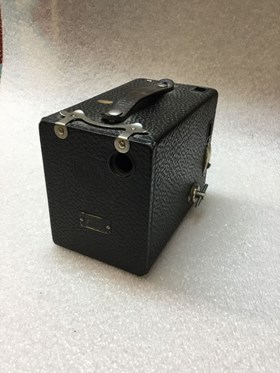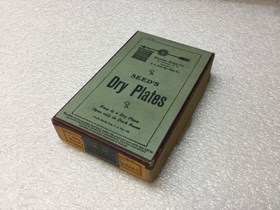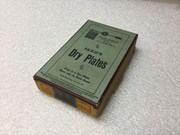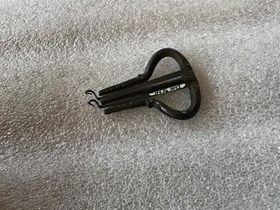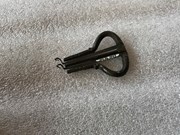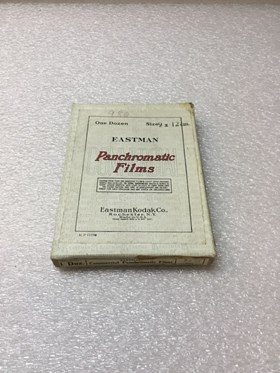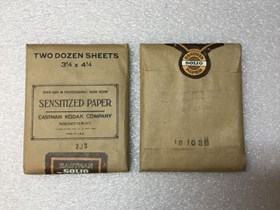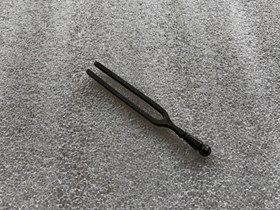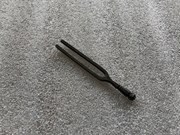Narrow Results By
Brownie Camera
https://archives.whyte.org/en/permalink/artifact104.41.0176
- Date
- 1901 – 1935
- Material
- leather; metal; cardboard; glass
- Catalogue Number
- 104.41.0176
- Description
- Dark brown/black Kodak No. 2 Brownie camera with a leather strap that has “BROWNIE’ stamped on it on the top, two viewfinders [one on top, one on the right side], a back panel that hinges open to access the film compartment [this compartment is metal and removable], a thin metal rod that rotates th…
1 image
- Title
- Brownie Camera
- Date
- 1901 – 1935
- Material
- leather; metal; cardboard; glass
- Dimensions
- 11.3 x 9.4 x 14.4 cm
- Description
- Dark brown/black Kodak No. 2 Brownie camera with a leather strap that has “BROWNIE’ stamped on it on the top, two viewfinders [one on top, one on the right side], a back panel that hinges open to access the film compartment [this compartment is metal and removable], a thin metal rod that rotates the film inside, and the lever that triggers the lens. Attached to the back is a small rectangular metal plaque with the manufacturer’s details and above it is an embossed stamp that identifies this camera as being “No. 120.”
- Credit
- Gift of Eddie Hunter, Banff, 1995
- Catalogue Number
- 104.41.0176
Images
This material is presented as originally created; it may contain outdated cultural descriptions and
potentially offensive content.
Read more.
Exposure Plates
https://archives.whyte.org/en/permalink/artifact104.41.0207
- Date
- 1902 – 1920
- Material
- cardboard; paper; glass;
- Catalogue Number
- 104.41.0207
- Description
- Box of one dozen 3 1/4 x 5 1/2 glass Seed’s Dry Plates with cut paper adhesive tape around the edges and bottom and manufacturer details printed on a pale green background throughout the lid. These dry plates were invented by M.A. Seed in 1879 and became very popular with photographers as the plate…
1 image
- Title
- Exposure Plates
- Date
- 1902 – 1920
- Material
- cardboard; paper; glass;
- Dimensions
- 3.0 x 9.3 x 15.0 cm
- Description
- Box of one dozen 3 1/4 x 5 1/2 glass Seed’s Dry Plates with cut paper adhesive tape around the edges and bottom and manufacturer details printed on a pale green background throughout the lid. These dry plates were invented by M.A. Seed in 1879 and became very popular with photographers as the plates came pre-prepared with the emulsion layer already applied - prior to “dry” plates, photographers would need portable dark rooms in which they would create their liquid emulsions prior to taking a photograph [known as “wet” plates]. Seed’s dry plates still required they be opened in a dark room, but this could be accomplished in the field by placing a dark sheet over the camera while loading and unloading the plates. In 1902, Eastman Kodak purchased Seed’s company [Seed Dry Plate Co.], but continued to capitalize on his name due to its reputation among consumers.
- Credit
- Gift of Robert Crosby Family, Banff, 1998
- Catalogue Number
- 104.41.0207
Images
This material is presented as originally created; it may contain outdated cultural descriptions and
potentially offensive content.
Read more.
- Date
- 1900 – 1930
- Material
- metal
- Catalogue Number
- 104.36.0003
- Description
- Lyre shaped cast iron frame with a third cast iron leg from the top of the harp down the middle between the outer legs. A double, flat, flexible, thin, vibrating tongue passes down on either side of the central leg to the end of the harp where the ends turn up at sharp right angles, ending in wire …
1 image
- Title
- Jew's Harp
- Date
- 1900 – 1930
- Material
- metal
- Dimensions
- 2.2 x 5.6 x 6.9 cm
- Description
- Lyre shaped cast iron frame with a third cast iron leg from the top of the harp down the middle between the outer legs. A double, flat, flexible, thin, vibrating tongue passes down on either side of the central leg to the end of the harp where the ends turn up at sharp right angles, ending in wire like hooks. The flexible tongue tapers from .3 cm wide to less than .1 cm at the hooked end. A series of three small, shallow, notches in the middle of each outer leg on the under side.
- Subject
- Whyte home
- households
- entertainment
- pastime
- Annie White
- music
- sound
- song
- accessories
- equipment
- Credit
- Gift of Catharine Robb Whyte, O. C., Banff, 1979
- Catalogue Number
- 104.36.0003
Images
This material is presented as originally created; it may contain outdated cultural descriptions and
potentially offensive content.
Read more.
Panchromatic Film
https://archives.whyte.org/en/permalink/artifact104.41.0201
- Date
- 1906 – 1923
- Material
- cardboard; paper;
- Catalogue Number
- 104.41.0201
- Description
- One box of a dozen 9x12cm Eastman Commercial Panchromatic Films - unopened. The box has a large paper label on the lid containing the manufacturer and development details throughout, as well as “9.80” written in pencil at the top. The edges and bottom of the box are sealed with brown paper adhesive…
1 image
- Title
- Panchromatic Film
- Date
- 1906 – 1923
- Material
- cardboard; paper;
- Dimensions
- 1.5 x 10.0 x 13.7 cm
- Description
- One box of a dozen 9x12cm Eastman Commercial Panchromatic Films - unopened. The box has a large paper label on the lid containing the manufacturer and development details throughout, as well as “9.80” written in pencil at the top. The edges and bottom of the box are sealed with brown paper adhesive tape, the right-hand side is stamped with “DEVELOP BEFORE APRIL 1923.”Panchromatic film is a kind of black-and-white emulsion that is sensitive to all visible light wavelengths and creates realistic photographs - it could also be used successfully for colour and black-and-white motion pictures as early as 1913. One downside to panchromatic film was that it had to be developed in complete darkness as it was sensitive to the red lights standard in many darkrooms.
- Credit
- Gift of Robert Crosby Family, Banff, 1998
- Catalogue Number
- 104.41.0201
Images
This material is presented as originally created; it may contain outdated cultural descriptions and
potentially offensive content.
Read more.
- Date
- 1905 – 1924
- Material
- paper;
- Catalogue Number
- 104.41.0200 a,b
- Description
- Two packages of 3 1/4 x 4 1/4 Kodak Sensitized Paper, also known as Solio Paper, in brown paper wrapping - unopened. Details of the contents stamped on the front in black ink, and the packages are held closed with a brown, orange, and white “EASTMAN SOLIO PAPER” sticker that wraps over the bottom e…
1 image
- Title
- Photo Paper
- Date
- 1905 – 1924
- Material
- paper;
- Dimensions
- 0.9 x 9.4 x 11.8 cm
- Description
- Two packages of 3 1/4 x 4 1/4 Kodak Sensitized Paper, also known as Solio Paper, in brown paper wrapping - unopened. Details of the contents stamped on the front in black ink, and the packages are held closed with a brown, orange, and white “EASTMAN SOLIO PAPER” sticker that wraps over the bottom edge from front to back. Faded stamps on the backs are mostly illegible, but the expiration date of “MAY 15 1924” is visible.
- Credit
- Gift of Robert Crosby Family, Banff, 1998
- Catalogue Number
- 104.41.0200 a,b
Images
This material is presented as originally created; it may contain outdated cultural descriptions and
potentially offensive content.
Read more.
- Date
- 1908 – 1908
- Material
- cardboard;
- Catalogue Number
- 104.41.0202
- Description
- Empty cardboard box of Kokak Solio Toning and Fixing Powder cartridges with manufacturer and product details printed throughout the white box in red and black. Toning powders were chemical compounds designed to react with the emulsion layers of positive photographs that altered the tone (or colour)…
1 image
- Title
- Solio Powder
- Date
- 1908 – 1908
- Material
- cardboard;
- Dimensions
- 2.2 x 10.2 x 8.8 cm
- Description
- Empty cardboard box of Kokak Solio Toning and Fixing Powder cartridges with manufacturer and product details printed throughout the white box in red and black. Toning powders were chemical compounds designed to react with the emulsion layers of positive photographs that altered the tone (or colour) of the image, usually turning a standard black-and-white image into warmer shades of red, brown, and/or purple - sepia is a very common tone. Additionally, toning powders could be combined with a fixing agent that stabilized the emulsion layer to prevent it breaking down or fading, flaking off, or otherwise ruining the image as it set.
- Subject
- Crosby family
- Abegweit
- photography
- photographic equipment
- chemicals
- photograph development
- Kodak;
- Credit
- Gift of Robert Crosby Family, Banff, 1998
- Catalogue Number
- 104.41.0202
Images
This material is presented as originally created; it may contain outdated cultural descriptions and
potentially offensive content.
Read more.
- Date
- 1900 – 1950
- Material
- metal
- Catalogue Number
- 104.01.0002
- Description
- A small Y shaped tuning fork of tempered steel with two long, square prongs coming together in a rounded yoke leading to an octagonal handle with a round knob on at end.
1 image
- Title
- Tuning Fork
- Date
- 1900 – 1950
- Material
- metal
- Dimensions
- 0.8 x 1.9 x 10.7 cm
- Description
- A small Y shaped tuning fork of tempered steel with two long, square prongs coming together in a rounded yoke leading to an octagonal handle with a round knob on at end.
- Credit
- Gift of Catharine Robb Whyte, O. C., Banff, 1979
- Catalogue Number
- 104.01.0002
Images
This material is presented as originally created; it may contain outdated cultural descriptions and
potentially offensive content.
Read more.

